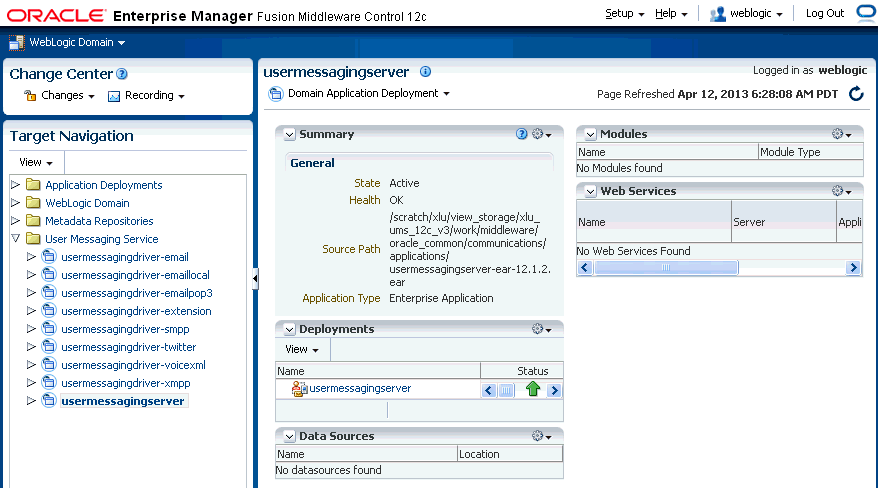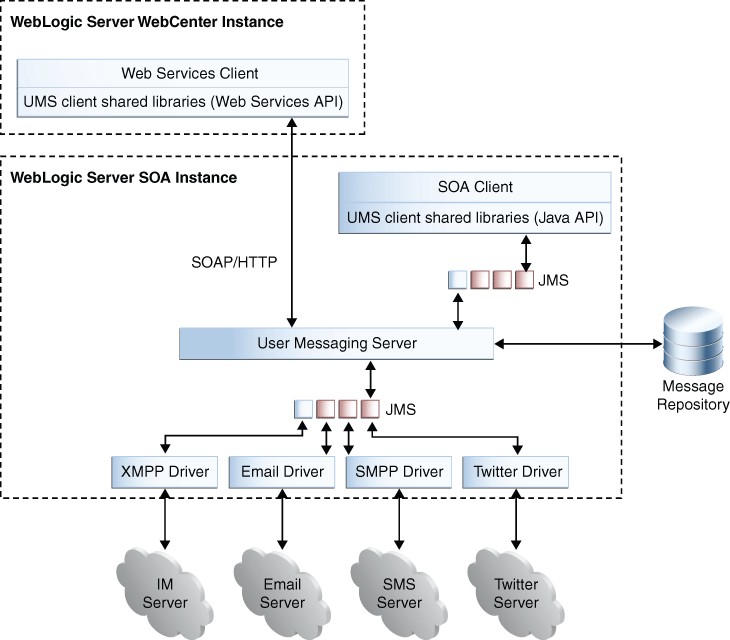1 Introduction to Oracle User Messaging Service
This chapter introduces you to Oracle User Messaging Service (UMS), and includes the following topics:
1.1 Introduction to User Messaging Service
Oracle User Messaging Service enables two-way communication between users and deployed applications. Key features include:
-
Support for a variety of messaging channels: Messages can be sent and received through email, instant messaging (IM) (XMPP), short message service (SMS) (SMPP), and voice. Messages can also be delivered to a user's SOA/Oracle WebCenter Portal worklist.
-
Two-way messaging: In addition to sending messages from applications to users (referred to as outbound messaging), users can initiate messaging interactions (inbound messaging). For example, a user can send an email or text message to a specified address; the message is routed to the appropriate application that can then respond to the user or invoke another process according to its business logic.
-
User messaging preferences: End users can use a web interface to define preferences for how and when they receive messaging notifications. Applications immediately become more flexible; rather than deciding whether to send to a user's email address or IM client, the application can simply send the message to the user, and let UMS route the message according to the user's preferences.
Note:
The User Messaging Preferences UI is available at:
http://host:port/sdpmessaging/userprefs-ui -
Robust message delivery: UMS keeps track of delivery status information provided by messaging gateways, and makes this information available to applications so that they can respond to a failed delivery. Or, applications can specify one or more failover addresses for a message in case delivery to the initial address fails. Using the failover capability of UMS frees application developers from having to implement complicated retry logic. This retry logic is also supported by the automatic resend feature that is introduced in 12c.
-
Pervasive integration within Oracle Fusion Middleware: UMS is integrated with other Fusion Middleware components providing a single consolidated bi-directional user messaging service.
-
Integration with Oracle BPEL Process Manager: Oracle JDeveloper includes prebuilt BPEL activities that enable messaging operations. Developers can add messaging capability to a SOA composite application by dragging and dropping the desired activity into any workflow.
-
Integration with human workflow: UMS enables the human workflow service engine to send actionable messages to and receive replies from users over email.
-
Integration with Oracle BAM: Oracle BAM uses UMS to send email alerts in response to monitoring events.
-
Integration with Oracle Oracle WebCenter Portal: UMS APIs are available to developers building applications for Oracle WebCenter Portal: Spaces. The API is a realization of Parlay X Web Services for Multimedia Messaging, version 2.1, a standard web service interface for rich messaging.
-
1.1.1 Components
There are three types of components that comprise Oracle User Messaging Service. These components are standard Java EE applications, making it easy to deploy and manage them using the standard tools provided with Oracle WebLogic Server.
-
UMS Server: The UMS Server orchestrates message flows between applications and users. The server routes outbound messages from a client application to the appropriate driver, and routes inbound messages to the correct client application. The server also maintains a repository of previously sent messages in a persistent store, and correlates delivery status information with previously sent messages.
-
UMS Drivers: UMS Drivers connect UMS to the messaging gateways, adapting content to the various protocols supported by UMS. Drivers can be deployed or undeployed independently of one another depending on what messaging channels are available in a given installation.
-
UMS Client applications: UMS client applications implement the business logic of sending and receiving messages. A UMS client application might be a SOA application that sends messages as one step of a BPEL workflow, or a WebCenter Portal Spaces application that can send messages from a web interface.
In addition to the components that comprise UMS itself, the other key entities in a messaging environment are the external gateways required for each messaging channel. These gateways are not a part of UMS or Oracle WebLogic Server. Since UMS Drivers support widely-adopted messaging protocols, UMS can be integrated with existing infrastructures such as a corporate email servers or XMPP (Jabber) servers. Alternatively, UMS can connect to outside providers of SMS or text-to-speech services that support SMPP or VoiceXML, respectively.
1.1.2 Architecture
The system architecture of Oracle User Messaging Service is shown in Figure 1-1.
UMS is now available as a part of JRF instead of SOA suite. This enables easier upper stack integration. For more information about configuring your domain using JRF templates, refer to chapter Configuring your Oracle Fusion Middleware Infrastructure Domain in Oracle Fusion Middleware Installing and Configuring the Oracle Fusion Middleware Infrastructure.
For maximum flexibility, the components of UMS are separate Java EE applications. This allows them to be deployed and managed independently of one another. For example, a particular driver can be stopped and reconfigured without affecting message delivery on all other channels.
Exchanges between UMS client applications and the UMS Server occur as SOAP/HTTP web service requests for web service clients, or through remote Enterprise JavaBeans (EJB) and JMS calls for BPEL messaging activities. Exchanges between the UMS Server and UMS drivers occur through JMS queues.
1.2 Introduction to Oracle User Messaging Service Configuration
Oracle User Messaging Service enables users to receive notifications sent from client applications that are developed and deployed to the Oracle Robotic Server using Oracle Developer.
For more information about Oracle JDeveloper, see Oracle Fusion Middle ware Developing Applications with Oracle JDeveloper.
To enable the workflow participants to receive and forward notifications, use Oracle Enterprise Manager Fusion Middleware Control to set the Oracle User Messaging Service environment by configuring the appropriate driver instances that reside on the same Oracle WebLogic Server on which you deploy the workflow application. See Figure 1-2. Oracle User Messaging Service includes drivers that support messaging through email, IM, SMS, and voice channels. For more information about configuring User Messaging Service, see Chapter 2, "Configuring Oracle User Messaging Service"
Figure 1-2 Oracle Enterprise Manager Fusion Middleware Control

Description of "Figure 1-2 Oracle Enterprise Manager Fusion Middleware Control"
For workflow participants to receive the notifications, they must register the devices that they use to access messages through User Communication Preferences For more information, see chapter User Communication Preferences in Oracle Fusion Middleware Developing Applications with Oracle User Messaging Service.
